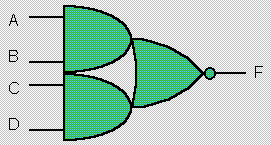A design is described in Verilog using the concept of a module. A module can be conceptualised as consisting of two parts, the port declarations and the module body. The port declarations represent the external interface to the module. The module body represents the internal description of the module - its behaviour, its structure, or a mixture of both. Let’s imagine we want to describe an and-or-invert (AOI) gate in Verilog.

Verilog: an AOI gate module
// Verilog code for AND-OR-INVERT gate module AOI (A, B, C, D, F); input A, B, C, D; output F; assign F = ~((A & B) | (C & D)); endmodule // end of Verilog code
OK, that’s the code. Let’s dissect it line by line...
// Verilog code for AND-OR-INVERT gate
Similar to many programming languages, Verilog
supports comments. There are two types of comment in Verilog,
line comments and block comments; we will look at line comments
for now. Comments are not part of the Verilog design, but allow
the user to make notes referring to the Verilog code, usually as
an aid to understanding it. Here the comment is a
“header” that tells us that the Verilog describes an
AOI gate. It is no more than an aide de memoire in this
case. A Verilog compiler will ignore this line of Verilog. Two
forward slashes mark the start of a line comment,
which is ignored by the Verilog compiler. A line comment can be
on a separate line or at the end of a line of Verilog code, but
in any case stops at the end of the line.
module AOI (A, B, C, D, F);
The name of the module is just an arbitrary label
invented by the user. It does not correspond to a name
pre-defined in a Verilog component library. module
is a Verilog keyword. This line defines the start of a new
Verilog module definition. All of the input and output ports of
the module must appear in parentheses after the module name. The
ordering of ports is not important for the module definition per
se, although it is conventional to specify input ports first.
input A, B, C, D;
output F;
The port declarations must repeat the names of the
ports in the module header. A port may correspond to a pin
on an IC, an edge connector on a board, or any logical channel of
communication with a block of hardware. Each port declaration
includes the name of one or more ports ( e.g., A, B
), and the direction that information is allowed to flow through
the ports (input, output or inout).
endmodule
The module definition is terminated by the Verilog
keyword endmodule.
Well, that’s the interface to the module taken care of, but what about it’s functionality?
assign F = ~((A & B) | (C & D));
In this module body, there is but one statement,
and all the names referenced in this statement are in fact the
ports of the design. Because all of the names used in the module
body are declared in the module header and port declarations,
there are no further declarations for internal elements required
in the module body. assign is a Verilog
keyword. It denotes a concurrent continuous assignment, which
describes the functionality of the module. The concurrent
assignment executes whenever one of the four ports A, B, C or D
change value. The ~, & and | symbols represent the bit-wise not,
and and or operators respectively, which are
built in to the Verilog language. That’s it! That’s all
there is to describing the functionality of an AOI gate in
Verilog.
// end of VHDL code
Another Verilog comment, and that’s the end of
a Verilog description for an AOI gate.
![]() Verilog
FAQ
Verilog
FAQ
![]() Doulos Training Courses
Doulos Training Courses
![]() Return to
Hardware Designers Guide Contents
Return to
Hardware Designers Guide Contents
Copyright 1995-1996 Doulos
This page was last updated 27th August 1996.
![]() We welcome your e-mail comments. Please contact us at: webmaster@doulos.co.uk
We welcome your e-mail comments. Please contact us at: webmaster@doulos.co.uk